Minnesota Native Documents Cambodian Dance in Earth in Flower
by Gretchen Mensink Lovejoy – © 2009 Bluff Country Newspaper Group
This article appears with permission of the copyright holder. No further reproduction is permitted
On seeing “Earth in Flower” Paul Cravath is thrilled, cover to cover. Minnesota Native Documents Cambodian Dance in Earth in Flower
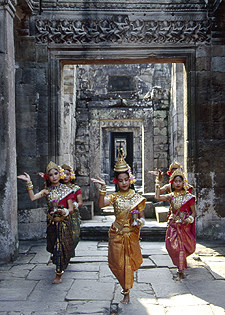
Chatfield, MN – “Some parts of the book are extremely interesting and some parts of it are simply for the preservation of documentation of the ballet for the Cambodian people,” said the 1962 Chatfield High School alum who is now professor of drama at Leeward College in Honolulu, Hawaii, and author of “Earth in Flower: The Divine Mystery of the Cambodian Dance Drama,” being presented as a St. Charles Author’s Night event.
“I wrote it as my doctoral dissertation at the University of Hawaii…when the Khmer Rouge took over the city of Phnom Penh in 1975, they did so at gunpoint and killed everyone connected with the royal family and royal court, of which the Royal Cambodian Ballet was a part. There was only one dance company, and any dancers, musicians or support personnel in the capital were killed – people estimate about 90 percent of the company died. I suspect the government knew it was going to happen, so that’s why they arranged for me to research this secretive royal legacy.”
The Fulbright scholar attended Luther College after graduating from Chatfield High School, then redeemed his scholarship in Indore, India, where “at the age of 21, my life changed completely … India was the best place to be in the world.”
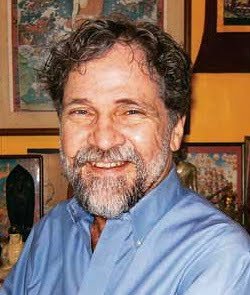
He taught for a year in Tokyo, earned his master’s degree in drama at Tulane University in New Orleans, then went on to continue his studies in Asian drama at the University of Hawaii. “The University of Hawaii has the best program in Asian theater, so I went there to pursue my Ph.D. in Asian drama. My professor actually was asked to do the Cambodian research,” Cravath explained, “but he couldn’t go. He told them that he had a graduate student who could go, so I did.
“When I got to Phnom Penh in January 1975, the city was surrounded. The Khmer Rouge were attacking the city with rockets. I wasn’t quite ready … I was shocked because there were rockets being fired into the city the day I arrived. It was a very strange place to be when the city was under attack … I realized, ‘Oh my gosh, this is war,’ but I watched ballet rehearsals because I was there to research this ancient dance tradition.”
Cravath explained that the Royal Cambodian Ballet is “not like any other ballet,” in that it is comprised solely of female dancers who, in previous eras, had been members of king’s harem. In the past, dancers entered the troupe as children and lived out their entire lives sequestered in the royal palace.
“There was a school for little girls – who started training at age 8 – the most beautiful little girls were chosen from each province. The very best ones were selected to perform in the national troupe. Their performances were sacred, and were mostly seen by the royal family, except for invited royal guests and public ceremonies.
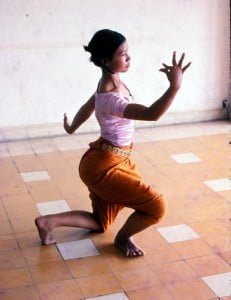
“The Cambodian ballet is much more than just a dance in the Western sense – the people believe that their dances, the most sacred of the dances, have power over the spirit world and secure the prosperity of their kingdom. Traditionally, dance was frequently performed for a specific purpose — to appeal to the gods for rain, for example — the dance and dancers were the kingdom’s connection to the spirit world, and represented the power of the king. This sacred rite held that the girls were the embodiment of creation, fertility and the earth itself …everything feminine was associated with the power of the earth. The female dancers represent the blossoming of the earth, which is the meaning of the book’s title ‘Earth in Flower.'”
Mandatory weekly check-ins at the American Embassy punctuated Cravath’s studies of this unique ballet, an art form that he preserved through photographs and meticulously detailed descriptions of each dance’s characters, their histories, and how the various choreographed motions were expressed.
Though Cravath was warned not to remain in Cambodia, he persisted in his research, even as the American government denied him assured protection and, according to mainstream media, “everything in Phnom Penh was just fine”.
“The official US State Department policy was also ‘everything’s just fine,’ when in fact, the Communist Khmer Rouge were tightening their grip on the capital.”
In Minnisota, area newspapers actually reported Cravath as having disappeared, though it would be several years until he found the articles his mother had saved. One read, “The parents of Paul Cravath, 30, a Chatfield native now in Phnom Penh, Cambodia, on a study program, have been informed that their son is alive and safe. Russell Cravath of Chatfield, Paul’s father, said the family had learned Tuesday that Paul is safe. They had been concerned since letters from Cambodia quit coming after Feb. 17.
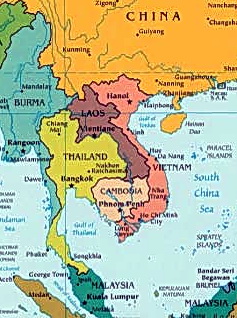
“The student’s father declined to say how word of his son’s safety was conveyed to him as he is afraid it would jeopardize his son’s future safety. He said his son had been advised to leave Cambodia because of the fighting but he does not know his son’s intentions. Paul Cravath arrived in Cambodia on Jan. 11 to study classical dance drama in order to earn a doctor of philosophy degree from the University of Hawaii.”
In early April 1975 he visited the embassy to check in as usual. The American ambassador informed him that Phnom Penh would be evacuated of foreigners the next morning and that Cravath was to be on the plane for Bangkok, Thailand.
“It wasn’t like the fall of Saigon where everyone tried to rush to get on the planes,” he related.
“We took a bus from the city. When we got to the airport, there were rockets being fired at the runways, so we had to run to a bunker and wait for our airplane. It was a military transport with no seats, only webbing to sit in. I could take only one bag, so I gave away my personal items and brought all my notes, interview tapes and photos.” In Thailand, Cravath was able to continue his dance research because Thai dance is drawn from older Cambodian traditions. By the end of the year he returned to Hawaii and “worked on my dissertation periodically,” but had other commitments that filled his time.
“Finally, in 1984, I finished the paper and got my degree. The world had forgotten about Cambodia, which was then under Communist control. I put the papers under my bed, and they lived there for the next 20 years. I tried to publish a couple times, but the university wanted to shorten it to just more than 200 pages, and I didn’t want to do that.
Twenty years later, a Khmer history researcher named Kent Davis read two sentences of my paper in a column someone wrote about it. He called me and I helped him obtain a copy of the thesis. Upon reading it Davis knew it should be published because it documented Cambodian history and lives that have now been destroyed. He describes it as a cultural treasure.”
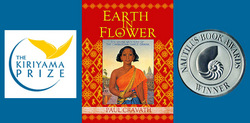
The resulting volume “is marketed primarily to libraries,” but is also available to collectors on Amazon and from a dedicated website: EarthInFlower.com. Cravath is pleased to see it bound and illustrated using many rare photographs he had taken 34 years ago.
“Only 886 copies were printed, and many are now in research libraries around the world. Strangely, on April 17th, 2008…the same day the Khmer Rouge took over Phnom Pehn…Kent’s house burned down and some of the remaining copies burned. I’m just happy to see my research in libraries now, because that’s where it belongs. The Cambodian ballet is a beautiful, beautiful dance form. This book helps to preserve its legacy.”

